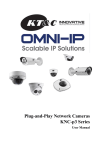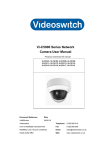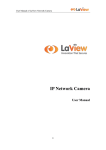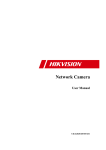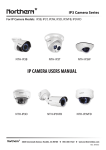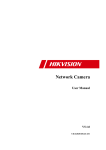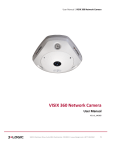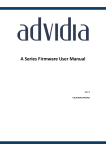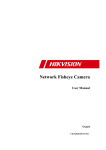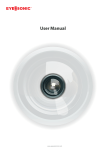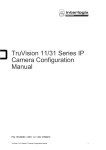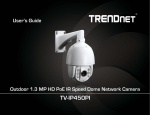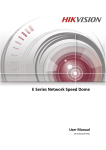Download Network Cameras
Transcript
Network Cameras NVC-BM1 NVC-DF1 NVC-DT1 NVC-DM1 User Manual V1.00 For further information, including full user and installation manual, and technical support please visit: www.hills.com.au/videosecurity 1 Table of Contents Chapter 1 System Requirement ....................................................................... 5 Chapter 2 Network Connection ....................................................................... 6 2.1 Setting the Network Camera over the LAN ........................................................ 6 2.1.1 Wiring over the LAN ......................................................................................................... 6 2.1.2 Detecting and Changing the IP Address ............................................................................ 7 2.2 Setting the Network Camera over the WAN ...................................................... 8 2.2.1 Static IP Connection .......................................................................................................... 8 2.2.2 Dynamic IP Connection ..................................................................................................... 9 Chapter 3 Access to the Network Camera .......................................................13 3.1 Accessing by Web Browsers ............................................................................ 13 3.2 Accessing by Client Software .......................................................................... 15 Chapter 4 Live View .......................................................................................17 4.1 Live View Page ............................................................................................... 17 4.2 Starting Live View .......................................................................................... 18 4.3 Recording and Capturing Pictures Manually .................................................... 18 Chapter 5 Network Camera Configuration .....................................................20 5.1 Configuring Local Parameters ......................................................................... 20 5.2 Configuring Time Settings .............................................................................. 22 5.3 Configuring Network Settings ......................................................................... 24 5.3.1 Configuring TCP/IP Settings ............................................................................................ 24 5.3.2 Configuring Port Settings ................................................................................................ 25 5.3.3 Configuring PPPoE Settings ............................................................................................. 26 5.3.4 Configuring DDNS Settings.............................................................................................. 26 5.3.5 Configuring SNMP Settings ............................................................................................. 29 5.3.6 Configuring 802.1X Settings ............................................................................................ 31 5.3.7 Configuring QoS Settings ................................................................................................ 31 5.3.8 Configuring UPnP™ Settings ........................................................................................... 32 5.3.9 Email Sending Triggered by Alarm .................................................................................. 33 5.3.10 Configuring NAT (Network Address Translation) Settings .......................................... 35 5.3.11 Configuring FTP Settings ............................................................................................ 35 5.3.12 HTTPS Settings ........................................................................................................... 37 5.4 Configuring Video and Audio Settings ............................................................. 39 5.4.1 Configuring Video Settings ............................................................................................. 39 5.4.2 Configuring Audio Settings ............................................................................................. 41 5.4.3 Configuring ROI Encoding ............................................................................................... 41 5.5 Configuring Image Parameters ........................................................................ 43 2 5.5.1 Configuring Display Settings ........................................................................................... 43 5.5.2 Configuring OSD Settings ................................................................................................ 48 5.5.3 Configuring Text Overlay Settings ................................................................................... 50 5.5.4 Configuring Privacy Mask................................................................................................ 51 5.5.5 Configuring Picture Overlay ............................................................................................ 52 5.6 Configuring and Handling Alarms ................................................................... 53 5.6.1 Configuring Motion Detection ........................................................................................ 53 5.6.2 Configuring Video Tampering Alarm .............................................................................. 59 5.6.3 Configuring Alarm Input ................................................................................................. 60 5.6.4 Configuring Alarm Output .............................................................................................. 61 5.6.5 Handling Exception ......................................................................................................... 62 5.6.6 Traversing Virtual Plane .................................................................................................. 63 5.6.7 Configuring Intrusion Detection ..................................................................................... 65 5.6.8 Configuring Defocus Detection ....................................................................................... 66 5.6.9 Configuring Scene Change Detection ............................................................................. 66 5.7 VCA Configuration .......................................................................................... 67 5.7.1 Behavior Analysis ............................................................................................................ 67 5.7.2 Face Capture ................................................................................................................... 73 Chapter 6 Storage Settings .............................................................................77 6.1 Configuring NAS Settings ................................................................................ 77 6.2 Configuring Recording Schedule ..................................................................... 79 6.3 Configuring Snapshot Settings ........................................................................ 83 Chapter 7 Playback........................................................................................86 Chapter 8 Log Searching ...............................................................................89 Chapter 9 Others ...........................................................................................90 9.1 Managing User Accounts ................................................................................ 90 9.2 Authentication ............................................................................................... 92 9.3 Anonymous Visit............................................................................................ 93 9.4 IP Address Filter ............................................................................................. 94 9.5 Security Service ............................................................................................. 95 9.6 Viewing Device Information ........................................................................... 96 9.7 Maintenance ................................................................................................. 96 9.7.1 Rebooting the Camera .................................................................................................... 96 9.7.2 Restoring Default Settings............................................................................................... 97 9.7.3 Exporting / Importing Configuration File ........................................................................ 97 9.7.4 Upgrading the System ..................................................................................................... 98 9.8 Service Settings .............................................................................................. 98 3 Appendix ........................................................................................................... 100 Appendix 1 HVS Discovery Tool Software Introduction ......................................... 100 Appendix 2 Port Mapping ...................................................................................... 103 4 Chapter 1 System Requirement Operating System: Microsoft Windows XP SP1 and above version / Vista / Win7 / Server 2003 / Server 2008 32bits CPU: Intel Pentium IV 3.0 GHz or higher RAM: 1G or higher Display: 1024×768 resolution or higher Web Browser: Internet Explorer 6.0 and above version, Safari 5.02 and above version, Mozilla Firefox 3.5 and above version and Google Chrome8 and above versions. 5 Chapter 2 Network Connection Before you start: Please refer to Section 2.1 Setting the Network Camera over the LAN to set the network camera via a LAN (Local Area Network). Please refer to Section 2.2 Setting the Network Camera over the WAN to set the network camera via a WAN (Wide Area Network). 2.1 Setting the Network Camera over the LAN Purpose: To view and configure the camera via a LAN, you need to connect the network camera in the same subnet with your computer, and install the HVS Discovery Toll or HVS PC Client software to search and change the IP of the network camera. Note: For the detailed introduction of HVS Discovery Tool, refer to Appendix 1. 2.1.1 Wiring over the LAN The following figures show the two ways of cable connection of a network camera and a computer: Purpose: To test the network camera, you can directly connect the network camera to the computer with a network cable as shown in Figure 2-1. Refer to the Figure 2-2 to set network camera over the LAN via a switch or a router. Figure 2-1 Connecting Directly 6 Figure 2-2 Connecting via a Switch or a Router 2.1.2 Detecting and Changing the IP Address You need the IP address to visit the network camera. Steps: 1. To get the IP address, you can choose either of the following methods: Use HVS Discovery Toll, a software tool which can automatically detect the online network cameras in the LAN and list the device information including IP address, subnet mask, port number, device serial number, device version, etc., shown in Figure 2-3. Use the HVS PC Client software to list the online devices. Please refer to the user manual of HVS PC Client software for detailed information. 2. Change the IP address and subnet mask to the same subnet as that of your computer. 3. Enter the IP address of network camera in the address field of the web browser to view the live video. Notes: By default DHCP is enabled, camera will search for DHCP server for a duration of 30 seconds. If there isn’t DHCP server in the network then use default fixed IP address. Default Fixed IP address is “10.1.1.1” and Subnet mask is “255.0.0.0”. The default user name is “admin”, and password is “admin”. For accessing the network camera from different subnets, please set the gateway for the network camera after you log in. 7 Figure 2-3 HVS Discovery Toll Interface 2.2 Setting the Network Camera over the WAN Purpose: This section explains how to connect the network camera to the WAN with a static IP or a dynamic IP. 2.2.1 Static IP Connection Before you start: Please apply a static IP from an ISP (Internet Service Provider). With the static IP address, you can connect the network camera via a router or connect it to the WAN directly. Connecting the network camera via a router Steps: 1. Connect the network camera to the router. 8 2. Assign a LAN IP address, the subnet mask and the gateway. Refer to Section 2.1.2 Detecting and Changing the IP Address for detailed IP address configuration of the camera. 3. Save the static IP in the router. 4. Set port mapping, e.g., 80, 8000, and 554 ports. The steps for port mapping vary according to the different routers. Please call the router manufacturer for assistance with port mapping. Note: Refer to Appendix 2 for detailed information about port mapping. 5. Visit the network camera through a web browser or the client software over the internet. Figure 2-4 Accessing the Camera through Router with Static IP Connecting the network camera with static IP directly You can also save the static IP in the camera and directly connect it to the internet without using a router. Refer to Section 2.1.2 Detecting and Changing the IP Address for detailed IP address configuration of the camera. Figure 2-5 Accessing the Camera with Static IP Directly 2.2.2 Dynamic IP Connection Before you start: Please apply a dynamic IP from an ISP. With the dynamic IP address, you can connect the network camera to a modem or a router. 9 Connecting the network camera via a router Steps: 1. Connect the network camera to the router. 2. In the camera, assign a LAN IP address, the subnet mask and the gateway. Refer to Section 2.1.2 Detecting and Changing the IP Address for detailed LAN configuration. 3. In the router, set the PPPoE user name, password and confirm the password. 4. Set port mapping. E.g. 80, 8000, and 554 ports. The steps for port mapping vary depending on different routers. Please call the router manufacturer for assistance with port mapping. Note: Refer to Appendix 2 for detailed information about port mapping. 5. Apply a domain name from a domain name provider. 6. Configure the DDNS settings in the setting interface of the router. 7. Visit the camera via the applied domain name. Connecting the network camera via a modem Purpose: This camera supports the PPPoE auto dial-up function. The camera gets a public IP address by ADSL dial-up after the camera is connected to a modem. You need to configure the PPPoE parameters of the network camera. Refer to Section 5.3.3 Configuring PPPoE Settings for detailed configuration. Figure 2-6 Accessing the Camera with Dynamic IP Note: The obtained IP address is dynamically assigned via PPPoE, so the IP address always changes after rebooting the camera. To solve the inconvenience of the dynamic IP, you need to get a domain name from the DDNS provider (E.g. DynDns.com). Please follow the steps below for normal domain name resolution and private domain name resolution to solve the problem. 10 Normal Domain Name Resolution Figure 2-7 Normal Domain Name Resolution Steps: 1. Apply a domain name from a domain name provider. 2. Configure the DDNS settings in the DDNS Settings interface of the network camera. Refer to Section 6.3.4 Configuring DDNS Settings for detailed configuration. 3. Visit the camera via the applied domain name. Private Domain Name Resolution Figure 2-8 Private Domain Name Resolution Steps: 1. Install and run the IP Server software in a computer with a static IP. 2. Access the network camera through the LAN with a web browser or the client software. 3. Enable DDNS and select IP Server as the protocol type. Refer to Section 6.3.4 Configuring DDNS Settings for detailed configuration. 11 12 Chapter 3 Access to the Network Camera 3.1 Accessing by Web Browsers Steps: 1. Open the web browser. 2. Input the IP address of the network camera in the address bar, e.g., 10.1.1.1 and press the Enter key to enter the login interface. 3. Input the user name and password and click Login. Figure 3-1 Login Interface Notes: The default user name is admin, and the default password is admin. 4. Install the plug-in before viewing the live video and operating the camera. Please follow the installation prompts to install the plug-in. 13 Figure 3-2 Download and Install Plug-in Figure 3-3 Install Plug-in (1) Figure 3-4 Install Plug-in (2) 14 Note: You may have to close the web browser to install the plug-in. Please reopen the web browser and log in again after installing the plug-in. 3.2 Accessing by Client Software Download HVS PC Client software from website www.hills.com.au/videosecurity. You can view the live video and manage the camera with the software. Follow the installation prompts to install the software. The control panel and live view interface of HVS PC Client software are shown as bellow. Figure 3-5 HVS PC Client Control Panel 15 Figure 3-6 HVS PC Client Configuration Panel Note: For detailed information about the software, please refer to the user manual of the HVS PC Client. 16 Chapter 4 Live View 4.1 Live View Page Purpose: The live view page allows you to view the real-time video, capture images, realize PTZ control, set/call presets and configure video parameters. Log in the network camera to enter the live view page, or you can click Live View on the menu bar of the main page to enter the live view page. Descriptions of the live view page: Figure 4-1 Live View Page Menu Bar: Click each tab to enter Live View, Playback, Log and Configuration page respectively. Display Control: Click each tab to adjust the layout and the stream type of the live view. And you can click the drop-down to select the plug-in. For IE (internet explorer) user, webcomponents and quick time are selectable. And for Non-IE user, webcomponents, quick time, VLC or MJPEG is selectable if they are supported by the web browser. Live View Window: Display the live video. 17 Toolbar: Operations on the live view page, e.g., live view, capture, record, audio on/off, two-way audio, etc. 4.2 Starting Live View In the live view window as shown in Figure 5-2, click on the toolbar to start the live view of the camera. Figure 4-2 Live View Toolbar Table 4-1 Descriptions of the Toolbar Icon Description Start/Stop live view. / The window size is 4:3. The window size is 16:9. The original widow size. Self-adaptive window size. Live view with the main stream. Live view with the sub stream. Live view with the third stream. Click to select the third-party plug-in. Manually capture the picture. Manually start/stop recording. / / Audio on and adjust volume /Mute. / Turn on/off microphone. / Turn on/off 3D zooming function. 4.3 Recording and Capturing Pictures Manually In the live view interface, click click on the toolbar to capture the live pictures or to record the live view. The saving paths of the captured pictures and clips can be set on the Configuration > Local Configuration page. To configure remote 18 scheduled recording, please refer to Section 7.2. Note: The captured image will be saved as JPEG file or BMP file in your computer. 19 Chapter 5 Network Camera Configuration 5.1 Configuring Local Parameters Note: The local configuration refers to the parameters of the live view, record files and captured pictures. The record files and captured pictures are the ones you record and captured using the web browser and thus the saving paths of them are on the PC running the browser. Steps: 1. Enter the Local Configuration interface: Configuration > Local Configuration Figure 5-1 Local Configuration Interface 2. Configure the following settings: Live View Parameters: Set the protocol type and live view performance. Protocol Type: TCP, UDP, MULTICAST and HTTP are selectable. TCP: Ensures complete delivery of streaming data and better video quality, yet the real-time transmission will be affected. UDP: Provides real-time audio and video streams. HTTP: Allows the same quality as of TCP without setting specific ports for 20 streaming under some network environments. MULTICAST: It’s recommended to select MCAST type when using the Multicast function. For detailed information about Multicast, refer to Section 6.3.1 TCP/IP Settings. Live View Performance: Set the live view performance to Shortest Delay, Real Time, Balanced or Best Fluency. Rules: It refers to the rules on your local browser, select enable or disable to display or not display the colored marks when the motion detection, face detection, or intrusion detection is triggered. E.g.: enabled as the rules are, and the face detection is enabled as well, when a face is detected, it will be marked with a green rectangle on the live view. Image Format: Choose the image format for picture capture. Record File Settings: Set the saving path of the recorded video files. Valid for the record files you recorded with the web browser. Record File Size: Select the packed size of the manually recorded and downloaded video files to 256M, 512M or 1G. After the selection, the maximum record file size is the value you selected. Save record files to: Set the saving path for the manually recorded video files. Save downloaded files to: Set the saving path for the downloaded video files in playback mode. Picture and Clip Settings: Set the saving paths of the captured pictures and clipped video files. Valid for the pictures you captured with the web browser. Save snapshots in live view to: Set the saving path of the manually captured pictures in live view mode. Save snapshots when playback to: Set the saving path of the captured pictures in playback mode. Save clips to: Set the saving path of the clipped video files in playback mode. Note: You can click Browse to change the directory for saving the clips and pictures. 3. Click Save to save the settings. 21 5.2 Configuring Time Settings Purpose: You can follow the instructions in this section to configure the time synchronization and DST settings. Steps: 1. Enter the Time Settings interface: Configuration > Basic Configuration > System > Time Settings Or Configuration > Advanced Configuration > System > Time Settings Figure 5-2 Time Settings Select the Time Zone. Select the Time Zone of your location from the drop-down menu. Synchronizing Time by NTP Server. (1) Check the checkbox to enable the NTP function. (2) Configure the following settings: Server Address: IP address of NTP server. NTP Port: Port of NTP server. Interval: The time interval between the two synchronizing actions with NTP server. 22 Figure 5-3 Time Sync by NTP Server Note: If the camera is connected to a public network, you should use a NTP server that has a time synchronization function, such as the server at the National Time Center (IP Address: 210.72.145.44). If the camera is set in a customized network, NTP software can be used to establish a NTP server for time synchronization. Synchronizing Time Synchronization Manually Enable the Manual Time Sync function and then click to set the system time from the pop-up calendar. Note: You can also check the Sync with computer time checkbox to synchronize the time of the camera with that of your computer. Figure 5-4 Time Sync Manually Click the DST tab page to enable the DST function and Set the date of the DST period. Figure 5-5 DST Settings 2. Click Save to save the settings. 23 5.3 Configuring Network Settings 5.3.1 Configuring TCP/IP Settings Purpose: TCP/IP settings must be properly configured before you operate the camera over network. The camera supports both the IPv4 and IPv6. Both versions may be configured simultaneously without conflicting to each other, and at least one IP version should be configured. Steps: 1. Enter TCP/IP Settings interface: Configuration > Basic Configuration > Network > TCP/IP Or Configuration > Advanced Configuration > Network > TCP/IP Figure 5-6 TCP/IP Settings 2. Configure the basic network settings, including the NIC Type, IPv4 or IPv6 Address, IPv4 or IPv6 Subnet Mask, IPv4 or IPv6 Default Gateway, MTU settings 24 and Multicast Address. Notes: The valid value range of MTU is 500 ~ 1500. The Multicast sends a stream to the multicast group address and allows multiple clients to acquire the stream at the same time by requesting a copy from the multicast group address. Before utilizing this function, you have to enable the Multicast function of your router. 3. Click Save to save the above settings. Note: A reboot is required for the settings to take effect. 5.3.2 Configuring Port Settings Purpose: You can set the port No. of the camera, e.g. HTTP port, RTSP port and HTTPS port. Steps: 1. Enter the Port Settings interface: Configuration > Basic Configuration > Network > Port Or Configuration > Advanced Configuration > Network > Port Figure 5-7 Port Settings 2. Set the HTTP port, RTSP port, HTTPS port and server port of the camera. HTTP Port: The default port number is 80, and it can be changed to any port No. which is not occupied. RTSP Port: The default port number is 554 and it can be changed to any port No. ranges from 1024 to 65535. 25 HTTPS Port: The default port number is 443, and it can be changed to any port No. which is not occupied. Server Port: The default server port number is 8000, and it can be changed to any port No. ranges from 2000 to 65535. 3. Click Save to save the settings. Note: A reboot is required for the settings to take effect. 5.3.3 Configuring PPPoE Settings Steps: 1. Enter the PPPoE Settings interface: Configuration >Advanced Configuration > Network > PPPoE Figure 5-8 PPPoE Settings 2. Check the Enable PPPoE checkbox to enable this feature. 3. Enter User Name, Password, and Confirm password for PPPoE access. Note: The User Name and Password should be assigned by your ISP. 4. Click Save to save and exit the interface. Note: A reboot is required for the settings to take effect. 5.3.4 Configuring DDNS Settings Purpose: If your camera is set to use PPPoE as its default network connection, you can use the Dynamic DNS (DDNS) for network access. Before you start: 26 Registration on the DDNS server is required before configuring the DDNS settings of the camera. Steps: 1. Enter the DDNS Settings interface: Configuration > Advanced Configuration > Network > DDNS Figure 5-9 DDNS Settings 2. Check the Enable DDNS checkbox to enable this feature. 3. Select DDNS Type. Four DDNS types are selectable: HiDDNS, IPServer , NO-IP, and DynDNS. DynDNS: Steps: (1)Enter Server Address of DynDNS (e.g. members.dyndns.org). (2)In the Domain text field, enter the domain name obtained from the DynDNS website. (3)Enter the Port of DynDNS server. (4)Enter the User Name and Password registered on the DynDNS website. (5)Click Save to save the settings. 27 Figure 5-10 DynDNS Settings IP Server: Steps: (1) Enter the Server Address of the IP Server. (2) Click Save to save the settings. Note: For the IP Server, you have to apply a static IP, subnet mask, gateway and preferred DNS from the ISP. The Server Address should be entered with the static IP address of the computer that runs the IP Server software. Figure 5-11 IPServer Settings Note: For the US and Canada area, you can enter 173.200.91.74 as the server address. NO-IP: Steps: (1) Choose the DDNS Type as NO-IP. 28 Figure 5-12 NO-IP DNS Settings (2) Enter the Server Address as www.noip.com (3) Enter the Domain name you registered. (4) Enter the Port number, if needed. (5) Enter the User Name and Password. (6) Click Save and then you can view the camera with the domain name. 5.3.5 Configuring SNMP Settings Purpose: You can set the SNMP function to get camera status, parameters and alarm related information and manage the camera remotely when it is connected to the network. Before you start: Before setting the SNMP, please download the SNMP software and manage to receive the camera information via SNMP port. By setting the Trap Address, the camera can send the alarm event and exception messages to the surveillance center. Note: The SNMP version you select should be the same as that of the SNMP software. And you also need to use the different version according to the security level you required. SNMP v1 provides no security and SNMP v2 requires password for access. And SNMP v3 provides encryption and if you use the third version, HTTPS protocol must be enabled. Steps: 1. Enter the SNMP Settings interface: 29 Configuration > Advanced Configuration > Network > SNMP Figure 5-13 SNMP Settings 2. Check the corresponding version checkbox ( , , ) to enable the feature. 3. Configure the SNMP settings. Note: The settings of the SNMP software should be the same as the settings you configure here. 4. Click Save to save and finish the settings. Note: A reboot is required for the settings to take effect. 30 5.3.6 Configuring 802.1X Settings Purpose: The IEEE 802.1X standard is supported by the network cameras, and when the feature is enabled, the camera data is secured and user authentication is needed when connecting the camera to the network protected by the IEEE 802.1X. Before you start: The authentication server must be configured. Please apply and register a user name and password for 802.1X in the server. Steps: 1. Enter the 802.1X Settings interface: Configuration > Advanced Configuration > Network > 802.1X Figure 5-14 802.1X Settings 2. Check the Enable IEEE 802.1X checkbox to enable the feature. 3. Configure the 802.1X settings, including EAPOL version, user name and password. Note: The EAPOL version must be identical with that of the router or the switch. 4. Enter the user name and password to access the server. 5. Click Save to finish the settings. Note: A reboot is required for the settings to take effect. 5.3.7 Configuring QoS Settings Purpose: 31 QoS (Quality of Service) can help solve the network delay and network congestion by configuring the priority of data sending. Steps: 1. Enter the QoS Settings interface: Configuration >Advanced Configuration > Network > QoS Figure 5-15 QoS Settings 2. Configure the QoS settings, including video / audio DSCP, event / alarm DSCP and Management DSCP. The valid value range of the DSCP is 0-63. The bigger the DSCP value is, the higher the priority is. Note: DSCP refers to the Differentiated Service Code Point; and the DSCP value is used in the IP header to indicate the priority of the data. 3. Click Save to save the settings. Note: A reboot is required for the settings to take effect. 5.3.8 Configuring UPnP™ Settings Universal Plug and Play (UPnP™) is a networking architecture that provides compatibility among networking equipment, software and other hardware devices. The UPnP protocol allows devices to connect seamlessly and to simplify the implementation of networks in the home and corporate environments. With the function enabled, you don’t need to configure the port mapping for each port, and the camera is connected to the Wide Area Network via the router. Steps: 1. Enter the UPnP™ settings interface. Configuration >Advanced Configuration > Network > UPnP 32 2. Check the checkbox to enable the UPnP™ function. The name of the device when detected online can be edited. Figure 5-16 Configure UPnP Settings 5.3.9 Email Sending Triggered by Alarm Purpose: The system can be configured to send an Email notification to all designated receivers if an alarm event is detected, e.g., motion detection event, video loss, video tampering, etc. Before you start: Please configure the DNS Server settings under Basic Configuration > Network > TCP/IP or Advanced Configuration > Network > TCP/IP before using the Email function. Steps: 1. Enter the TCP/IP Settings (Configuration > Basic Configuration > Network > TCP/IP or Configuration > Advanced Configuration > Network > TCP/IP) to set the IPv4 Address, IPv4 Subnet Mask, IPv4 Default Gateway and the Preferred DNS Server. Note: Please refer to Section 6.3.1 Configuring TCP/IP Settings for detailed information. 2. Enter the Email Settings interface: Configuration > Advanced Configuration > Network > Email 33 Figure 5-17 Email Settings 3. Configure the following settings: Sender: The name of the email sender. Sender’s Address: The email address of the sender. SMTP Server: The SMTP Server IP address or host name (e.g., smtp.263xmail.com). SMTP Port: The SMTP port. The default TCP/IP port for SMTP is 25 (not secured). And the SSL SMTP port is 465. Enable SSL: Check the checkbox to enable SSL if it is required by the SMTP server. Attached Image: Check the checkbox of Attached Image if you want to send emails with attached alarm images. Interval: The interval refers to the time between two actions of sending attached pictures. Authentication (optional): If your email server requires authentication, check this checkbox to use authentication to log in to this server and enter the login user 34 Name and password. Choose Receiver: Select the receiver to which the email is sent. Up to 2 receivers can be configured. Receiver: The name of the user to be notified. Receiver’s Address: The email address of user to be notified. 4. Click Save to save the settings. 5.3.10 Configuring NAT (Network Address Translation) Settings Purpose: 1. Enter the NAT settings interface. Configuration >Advanced Configuration > Network > NAT 2. Choose the port mapping mode. To port mapping with the default port numbers: Choose Port Mapping Mode. To port mapping with the customized port numbers: Choose And for manual port mapping, you can customize the value of the port number by yourself. Figure 5-18 Configure NAT Settings 3. Click Save to save the settings. 5.3.11 Configuring FTP Settings Purpose: You can configure the FTP server related information to enable the uploading of the captured pictures to the FTP server. The captured pictures can be triggered by events or a timing snapshot task. 35 Steps: 1. Enter the FTP Settings interface: Configuration >Advanced Configuration > Network > FTP Figure 5-19 FTP Settings 2. Configure the FTP settings; and the user name and password are required for login the FTP server. Directory: In the Directory Structure field, you can select the root directory, parent directory and child directory. When the parent directory is selected, you have the option to use the Device Name, Device Number or Device IP for the name of the directory; and when the Child Directory is selected, you can use the Camera Name or Camera No. as the name of the directory. Upload type: To enable uploading the captured picture to the FTP server. Anonymous Access to the FTP Server (in which case the user name and password won’t be required.): Check the Anonymous checkbox to enable the anonymous access to the FTP server. Figure 5-20 FTP Settings Note: The anonymous access function must be supported by the FTP server. 36 3. Click Save to save the settings. Note: If you want to upload the captured pictures to FTP server, you have to enable the continuous snapshot or event-triggered snapshot on Snapshot page. For detailed information, please refer to the Section 6.6.7. 5.3.12 HTTPS Settings Purpose: HTTPS provides authentication of the web site and associated web server that one is communicating with, which protects against Man-in-the-middle attacks. Perform the following steps to set the port number of https. Example: If you set the port number as 443 and the IP address is 192.0.0.64, you may access the device by inputting https://192.0.0.64:443 via the web browser. Steps: 1. Enter the HTTPS settings interface. Configuration > Advanced Configuration > Network > HTTPS 2. Create the self-signed certificate or authorized certificate. Figure 5-21 HTTPS Settings Create the self-signed certificate 37 1) Click Create button to enter the creation interface. Figure 5-22 Create Self-signed Certificate 2) Enter the country, host name/IP, validity and other information. 3) Click OK to save the settings. Note: If you already had a certificate installed, the Create Self-signed Certificate is grayed out. Create the authorized certificate 1) Click Create button to create the certificate request. 2) Download the certificate request and submit it to the trusted certificate authority for signature. 3) After receiving the signed valid certificate, import the certificate to the device. 3. There will be the certificate information after you successfully create and install the certificate. Figure 5-23 Installed Certificate 4. Click the Save button to save the settings. 38 5.4 Configuring Video and Audio Settings 5.4.1 Configuring Video Settings Steps: 1. Enter the Video Settings interface: Configuration >Basic Configuration > Video / Audio > Video Or Configuration > Advanced Configuration > Video / Audio > Video Figure 5-24 Configure Video Settings 2. Select the Stream Type of the camera to main stream (normal), sub-stream or third stream. The main stream is usually for recording and live viewing with good bandwidth, and the sub-stream and third stream can be used for live viewing when the bandwidth is limited. 3. You can customize the following parameters for the selected main stream or sub-stream: Video Type: Select the stream type to video stream, or video & audio composite stream. The audio signal will be recorded only when the Video Type is Video & Audio. 39 Resolution: Select the resolution of the video output. Bitrate Type: Select the bitrate type to constant or variable. Video Quality: When bitrate type is selected as Variable, 6 levels of video quality are selectable. Frame Rate: Set the frame rate to 1/16~25 fps. The frame rate is to describe the frequency at which the video stream is updated and it is measured by frames per second (fps). A higher frame rate is advantageous when there is movement in the video stream, as it maintains image quality throughout. Max. Bitrate: Set the max. bitrate to 32~16384 Kbps. The higher value corresponds to the higher video quality, but the higher bandwidth is required. Video Encoding: If the Stream Type is set to main stream, H.264 and MJPEG are selectable, and if the stream type is set to sub stream, H.264, MJPEG, and MPEJ4 are selectable. Note: The supported video encoding may differ according to the different platform. Profile: Basic profile, Main Profile and High Profile for coding are selectable. I Frame Interval: Set the I-Frame interval to 1~400. SVC: Scalable Video Coding is an extension of the H.264/AVC standard. Set it OFF or ON according to your actual needs. Smoothing: It refers to the smoothness of the stream. The higher value of the smoothing, the better fluency of the stream, though, the video quality may not be so satisfied. The lower value of the smoothing, the higher quality of the stream, though it may 40 appear not fluent. 4. Click Save to save the settings. 5.4.2 Configuring Audio Settings Steps: 1. Enter the Audio Settings interface Configuration > Basic Configuration > Video / Audio > Audio Or Configuration > Advanced Configuration > Video / Audio > Audio Figure 5-25 Audio Settings 2. Configure the following settings. Audio Encoding: G.711 ulaw, G.711alaw, G.726, and MP2L2 are selectable. And 32kbps, 64kbps, and 128kbps are supported if MP2L2 is selected. Audio Input: MicIn and Linein are selectable for the connected microphone and pickup respectively. Input Volume: 0-100 Environmental Noise Filter: Set it as OFF or ON. When you set the function on the noise detected can be filtered. 3. Click Save to save the settings. 5.4.3 Configuring ROI Encoding ROI stands for the region of interest. And the ROI encoding enables you to discriminate the ROI and background information in compression, that is to say, the technology assigns more encoding resource to the region of interest to increase the 41 quality of the ROI whereas the background information is less focused. Steps: 1. Enter the ROI settings interface Configuration > Advanced Configuration > Video / Audio >ROI Figure 5-26 Region of Interest Settings 2. Draw the region of interest on the image. There are four regions can be drawn. 3. Choose the stream type to set the ROI encoding. 4. Choose the ROI type. There are two options for ROI encoding, the fixed region encoding and the dynamic tracking. 42 The fixed region encoding is the ROI encoding for the manually configured area. And you can choose the Image Quality Enhancing level for ROI encoding, and you can also name the ROI area. The dynamic region refers to the ROI defined by intelligent analysis such as human face detection. You can choose the Image Quality Enhancing level for the ROI encoding. 5. Click Save to save the settings. 5.5 Configuring Image Parameters 5.5.1 Configuring Display Settings Purpose: You can set the image quality of the camera, including brightness, contrast, saturation, hue, sharpness, etc. Note: The display parameters vary according to the different camera model. Please refer to the actual interface for details. Steps: 1. Enter the Display Settings interface: Configuration > Basic Configuration> Image> Display Settings Or Configuration > Advanced Configuration> Image> Display Settings 2. Set the image parameters of the camera. Note: In order to guarantee the image quality in the different illumination, it provides two sets of parameters for user to configure. Day/night Auto-switch 43 Figure 5-27 Display Settings of Day/night Auto-switch Image Adjustment Brightness describes bright of the image, which ranges from 1~100, and the default value is 50. Contrast describes the contrast of the image, which ranges from 1~100, and the default value is 50. Saturation describes the colorfulness of the image color, which ranges from 1~100, and the default value is 50. Sharpness describes the edge contrast of the image, which ranges from 1~100, and the default value is 50. Exposure Settings If the camera is equipped with the fixed lens, only Manual is selectable, and the iris mode is not configurable. If Auto is selected, you can set the auto iris level from 0~ 100. For the camera supports P-Iris lens, if P-Iris lens is adopted, then the P-Iris lens type is selectable, e.g.: Tamron 2.8-8mm F1.2 (M13VP288-IR), or if DC lens is adopted, then manual and auto are selectable. The exposure time refers to the electronic shutter time, which ranges from 1 ~ 44 1/100,000s. Adjust it according to the actual luminance condition. Focus Settings For the camera supports electronic lens, you can set the focus mode as Manual or Auto. If auto is selected, the focus is adjusted automatically, and if manual is selected, you can control the lens by adjusting the zoom, focus, lens initialization, and auxiliary focus via the PTZ control interface. Day/Night Switch Select the day/night switch mode, and configure the smart IR settings from this option. Figure 5-28 Day/Night Switch Day, night, auto, schedule, and triggered by alarm input are selectable for day/night switch. Day: the camera stays at day mode. Night: the camera stays at night mode. Auto: the camera switches between the day mode and the night mode according to the illumination automatically. The sensitivity ranges from 0~7, the higher the value is, the easier the mode switches. The filtering time refers to the interval time between the day/night switch. You can set it from 5s to 120s. Schedule: Set the start time and the end time to define the duration for day/night mode. Triggered by alarm input: The switch is triggered by alarm input, and you can set the triggered mode to day or night. Smart IR gives user an option to turn ON / OFF the IR LED. Set the smart IR to ON, and Auto and Manual are selectable for IR mode. Select 45 AUTO, and the IR LED changes according to the actual luminance. E.g.: if the current scene is bright enough, then the IR LED adjusts itself to lower power; and if the scene is not bright enough, the IR LED adjusts itself to higher power. Select Manual, and you can adjust the IR LED by adjusting the distance. E.g.: If the object is near the camera, the device adjusts the IR LED to lower power, and the IR LED is in higher power if the object is far. Backlight Settings BLC: If you focus on an object against strong backlight, the object will be too dark to be seen clearly. BLC compensates light to the object in the front to make it clear. OFF, Up, Down, Left, Right, Center and customize are selectable. WDR: Wide Dynamic Range can be used when there is a high contrast of the bright area and the dark area of the scene. HLC: High Light Compression function can be used when there are strong lights in the scene affecting the image quality. White Balance White balance is the white rendition function of the camera used to adjust the color temperature according to the environment. Figure 5-29 White Balance Image Enhancement Digital Noise Reduction: DNR reduces the noise in the video stream. OFF, Normal Mode and Expert Mode are selectable. Set the DNR level from 0~100, and the default value is50 in Normal Mode. Set the DNR level from both space DNR level [0~100] and time DNR level [0~100] in Expert Mode. Defog Mode: You can enable the defog function when the environment is foggy and 46 the image is misty. It enhances the subtle details so that the image appears clearer. Electrical Image Stabilizer: EIS reduces the effects of vibration in a video. Grey Scale: You can choose the range of the grey scale as [0-255] or [16-235]. Video Adjustment Mirror: It mirrors the image so you can see it inversed. Left/Right, Up/Down, Center, and OFF are selectable. Rotate: To make a complete use of the 16:9 aspect ratio, you can enable the rotate function when you use the camera in a narrow view scene. When installing, turn the camera to the 90 degrees or rotate the 3-axis lens to 90 degrees, and set the rotate mode as on, you will get a normal view of the scene with 9:16 aspect ratio to ignore the needless information such as the wall, and get more meaningful information of the scene. Scene Mode: Choose the scene as indoor or outdoor according to the real environment. Video Standard: 50 Hz and 60 Hz are selectable. Choose according to the different video standards; normally 50 Hz for PAL standard and 60 Hz for NTSC standard. Capture Mode: It’s the selectable video input mode to meet the different demands of field of view and resolution. Other Some of the camera supports CVBS, SDI, or HDMI output. Please refer to the actual camera model for details. Day/Night Scheduled-Switch Day/Night scheduled-switch configuration interface enables you to set the separate camera parameters for day and night to guarantee the image quality in different illumination. 47 Figure 5-30 Day/Night Scheduled-Switch Configuration Interface Steps: 1. Click the time line to select the start time and the end time of the switch. 2. Click Common tab to configure the common parameters applicable to the day mode and night mode. Note: The detailed information of each parameter please refers to day/night auto switch session. 3. Click Day tab to configure the parameters applicable for day mode. 4. Click Night tab to configure the parameters applicable for night mode. Note: The settings saved automatically if any parameter is changed. 5.5.2 Configuring OSD Settings Purpose: You can customize the camera name and time on the screen. Steps: 1. Enter the OSD Settings interface: 48 Configuration > Advanced Configuration > Image > OSD Settings Figure 5-31 OSD Settings 2. Check the corresponding checkbox to select the display of camera name, date or week if required. 3. Edit the camera name in the text field of Camera Name. 4. Select from the drop-down list to set the time format, date format, display mode and the OSD font size. 5. Define the font color of the OSD by clicking the drop-down, and black & white self-adaptive and custom are selectable. Figure 5-32 Font Color-Custom 6. You can use the mouse to click and drag the text frame live view window to adjust the OSD position. 49 in the Figure 5-33 Adjust OSD Location 7. Click Save to activate the above settings. 5.5.3 Configuring Text Overlay Settings Purpose: You can customize the text overlay. Steps: 1. Enter the Text Overlay Settings interface: Configuration > Advanced Configuration > Image > Text Overlay Figure 5-34 Text Overlay 50 2. Check the checkbox in front of textbox to enable the on-screen display. 3. Input the characters in the textbox. 4. (Optional)Use the mouse to click and drag the red text frame in the live view window to adjust the text overlay position. 5. Click Save. Note: Up to 8 text overlays are configurable. 5.5.4 Configuring Privacy Mask Purpose: Privacy mask enables you to cover certain areas on the live video to prevent certain spots in the surveillance area from being live viewed and recorded. Steps: 1. Enter the Privacy Mask Settings interface: Configuration > Advanced Configuration> Image > Privacy Mask 2. Check the checkbox of Enable Privacy Mask to enable this function. 3. Click Draw Area. Figure 5-35 Privacy Mask Settings 4. Click and drag the mouse in the live video window to draw the mask area. Note: You are allowed to draw up to 4 areas on the same image. 51 5. Click Stop Drawing to finish drawing or click Clear All to clear all of the areas you set without saving them. 6. Click Save to save the settings. 5.5.5 Configuring Picture Overlay Purpose: Picture overlay enables you to overlay a picture on the image. This function enables a certain enterprise or users to overlay their logo on the image. Note: The picture must be in RGB24 bmp format and the maximum size of the picture is 128*128. Steps: 1. Enter the Picture Overlay Settings interface: Configuration > Advanced Configuration> Image > Picture Overlay Figure 5-36 Picture Overlay 2. Click Browse to select a picture. 3. Click Upload to upload it. 4. Check Enable Picture Overlay checkbox to enable the function. X Coordinate and Y Coordinate values are for the location of the picture on the image. And the Picture width and height shows the size of the picture. 52 5.6 Configuring and Handling Alarms This section explains how to configure the network camera to respond to alarm events, including motion detection, video tampering, alarm input, alarm output, exception, face detection, audio exception detection, intrusion detection, defocus detection, and scene change detection, etc. These events can trigger the linkage methods, such as Notify Surveillance Center, Send Email, Trigger Alarm Output, etc. Notes: Check the checkbox of Notify Surveillance Center if you want to the alarm information pushed to your mobile phone as soon as the alarm is triggered. Click for help when you configure the intelligent functions, including face detection, audio exception detection, intrusion detection, defocus detection, scene change detection, etc. A help document will guide you to go through the configuration steps. 5.6.1 Configuring Motion Detection Purpose: Motion detection detects the moving objects in the configured surveillance area, and triggers the certain action as a respond to detection. In order to detect the moving objects accurately and reduce the false alarm rate, normal configuration and expert configuration are selectable for different motion detection environment. Normal Configuration Normal configuration adopts one set of parameter for motion detection during the day and at night. Tasks: 1. Set the Motion Detection Area. Steps: (1)Enter the motion detection settings interface 53 Configuration > Advanced Configuration> Events > Motion Detection (2)Check the checkbox of Enable Motion Detection. (3)Check the checkbox of Enable Dynamic Analysis for Motion if you want to mark the detected objects with green rectangles. Note: Select Disable for rules if you don’t want the detected objected displayed with the rectangles. Select disable from Configuration-Local Configuration-Live View Parameters-rules. Figure 5-37 Enable Motion Detection (4)Click Draw Area. Click and drag the mouse on the live video to draw a motion detection area. (5)Click Stop Drawing to finish drawing one area. (6)(Optional) Click Clear All to clear all of the areas. (7)(Optional) Move the slider to set the sensitivity of the detection. 2. Set the Arming Schedule for Motion Detection. Steps: 54 Figure 5-38 Arming Time (1)Click Edit to edit the arming schedule. The Figure 6-34 shows the editing interface of the arming schedule. (2)Choose the day you want to set the arming schedule. (3)Click to set the time period for the arming schedule. (4)(Optional) After you set the arming schedule, you can copy the schedule to other days. (5)Click OK to save the settings. Note: The time of each period can’t be overlapped. Up to 4 periods can be configured for each day. Figure 5-39 Arming Time Schedule 55 3. Set the Alarm Actions for Motion Detection. Check the checkbox to select the linkage method. Notify surveillance center, send email, upload to FTP, trigger channel and trigger alarm output are selectable. You can specify the linkage method when an event occurs. Figure 5-40 Linkage Method Audible Warning Trigger the audible warning locally. And it only supported by the device have the audio output. Notify Surveillance Center Send an exception or alarm signal to remote management software when an event occurs. Send Email Send an email with alarm information to a user or users when an event occurs. Note: To send the Email when an event occurs, you need to refer to Section 6.6.6 to set the related parameters. Upload to FTP Capture the image when an alarm is triggered and upload the picture to a FTP server. Note: Set the FTP address and the remote FTP server first. Refer to Section 6.3.10 for detailed information. Trigger Channel The video will be recorded when the motion is detected. You have to set the recording schedule to realize this function. Please refer to Section 7.2 for 56 detailed information. Trigger Alarm Output Trigger one or more external alarm outputs when an event occurs. Note: To trigger an alarm output when an event occurs, please refer to Section 6.6.4 to set the related parameters. Expert Configuration Expert mode is mainly used to configure the sensitivity and proportion of object on area of each area for different day/night switch. Figure 5-41 Expert Mode of Motion Detection Day/Night Switch OFF Steps: (1) Draw the detection area as in the normal configuration mode. Up to 8 areas are supported. (2)Select OFF for Switch Day and Night Settings. (3)Select the area by clicking the area No. (4)Slide the cursor to adjust the sensitivity and proportion of object on the area for the selected area. (5)Set the arming schedule and linkage method as in the normal configuration mode. (6)Click Save to save the settings. 57 Day/Night Auto-Switch Steps: (1) Draw the detection area as in the normal configuration mode. Up to 8 areas are supported. (2)Select Auto-Switch for Switch Day and Night Settings. Figure 5-42 Day/Night Auto-Switch (3)Select the area by clicking the area No. (4)Slide the cursor to adjust the sensitivity and proportion of object on the area for the selected area in the daytime. (5)Slide the cursor to adjust the sensitivity and proportion of object on the area for the selected area at night. (6)Set the arming schedule and linkage method as in the normal configuration mode. (7)Click Save to save the settings. Day/Night Scheduled-Switch (1) Draw the detection area as in the normal configuration mode. Up to 8 areas are supported. (2)Select Scheduled-Switch for Switch Day and Night Settings. 58 Figure 5-43 Day/Night Scheduled-Switch (3)Select the start time and the end time for the switch timing. (4)Select the area by clicking the area No. (5)Slide the cursor to adjust the sensitivity and proportion of object on the area for the selected area in the daytime. (6)Slide the cursor to adjust the sensitivity and proportion of object on the area for the selected area at night. (7)Set the arming schedule and linkage method as in the normal configuration mode. (8)Click Save to save the settings. 5.6.2 Configuring Video Tampering Alarm Purpose: You can configure the camera to trigger the alarm when the lens is covered and take alarm response action. Steps: 1. Enter the video tampering Settings interface: Configuration > Advanced Configuration > Events > Video Tampering 59 Figure 5-44 Video Tampering Alarm 2. Check Enable Video Tampering checkbox to enable the video tampering detection. 3. Set the video tampering area; refer to Task 1 Set the Motion Detection Area in Section 6.6.1. 4. Click Edit to edit the arming schedule for video tampering. The arming schedule configuration is the same as the setting of the arming schedule for motion detection. Refer to Task 2 Set the Arming Schedule for Motion Detection in Section 6.6.1. 5. Check the checkbox to select the linkage method taken for the video tampering. Audible warning, notify surveillance center, send email and trigger alarm output are selectable. Please refer to Task 3 Set the Alarm Actions for Motion Detection in Section 6.6.1. 6. Click Save to save the settings. 5.6.3 Configuring Alarm Input Steps: 1. Enter the Alarm Input Settings interface: Configuration > Advanced Configuration> Events > Alarm Input: 60 2. Choose the alarm input No. and the Alarm Type. The alarm type can be NO (Normally Open) and NC (Normally Closed). Edit the name to set a name for the alarm input (optional). Figure 5-45 Alarm Input Settings 3. Click Edit to set the arming schedule for the alarm input. Refer to Task 2 Set the Arming Schedule for Motion Detection in Section 6.6.1. 4. Check the checkbox to select the linkage method taken for the alarm input. Refer to Task 3 Set the Alarm Actions for Motion Detection in Section 6.6.1. 5. You can also choose the PTZ linking for the alarm input if your camera is installed with a pan/tilt unit. Check the relative checkbox and select the No. to enable Preset Calling, Patrol Calling or Pattern Calling. 6. You can copy your settings to other alarm inputs. 7. Click Save to save the settings. 5.6.4 Configuring Alarm Output Steps: 1. Enter the Alarm Output Settings interface: 61 Configuration>Advanced Configuration> Events > Alarm Output 2. Select one alarm output channel in the Alarm Output drop-down list. You can also set a name for the alarm output (optional). 3. The Delay time can be set to 5sec, 10sec, 30sec, 1min, 2min, 5min, 10min or Manual. The delay time refers to the time duration that the alarm output remains in effect after alarm occurs. 4. Click Edit to enter the Edit Schedule Time interface. The time schedule configuration is the same as the settings of the arming schedule for motion detection Refer to Task 2 Set the Arming Schedule for Motion Detection in Section 6.6.1. 5. You can copy the settings to other alarm outputs. 6. Click Save to save the settings. Figure 5-46 Alarm Output Settings 5.6.5 Handling Exception The exception type can be HDD full, HDD error, network disconnected, IP address conflicted and illegal login to the cameras. 62 Steps: 1. Enter the Exception Settings interface: Configuration > Advanced Configuration> Events > Exception 2. Check the checkbox to set the actions taken for the Exception alarm. Refer to Task 3 Set the Alarm Actions Taken for Motion Detection in Section 6.6.1. Figure 5-47 Exception Settings 3. Click Save to save the settings. 5.6.6 Traversing Virtual Plane This function can be used for detecting people, vehicles and objects traversing a pre-defined virtual plane. The traversing direction can be set as bidirectional, from left to right or from right to left. And a series of linkage method will be triggered if any object is detected. Steps: 1. Check the Enable Traversing Virtual Plane Detection checkbox. 2. Click the Draw Area, and a virtual plane will show on the image. 3. Click on the line, and you will see two red squares on each end, drag one of the red squares to define the arming area. 63 Figure 5-48 Draw Virtual Plane And you can select the directions as A<->B, A ->B, and B->A. A<->B: Only the arrow on the B side shows; when an object going across the plane with both direction can be detected and alarms are triggered. A->B: Only the object crossing the virtual plane from the A side to the B side can be detected. B->A: Only the object crossing the virtual plane from the B side to the A side can be detected. 4. Set the sensitivity [1~100]. 5. Choose another virtual plane on the dropdown list to configure. Up to 4 virtual planes are configurable. 6. Click Save to save the settings. 64 5.6.7 Configuring Intrusion Detection Intrusion detection can set an area in the surveillance scene and once the area is been entered, a set of alarm action is triggered. Steps: 1. Check the Enable Intrusion Detection checkbox. 2. Click Draw Area, and then draw a rectangle on the image as a defense region. Note: when you draw the rectangle, all lines should connect end to end to each other. Up to four areas are supported. Figure 5-49 Configuring Intrusion Area You can click Clear to clear the areas you drawn. The defense region parameters can be set separately. 3. Choose the region to be configured. Threshold: Range [0-10s], the threshold for the time of the object loitering in the region. If you set the value as 0, alarm is triggered immediately after the object entering the region. Sensitivity: Range [1-100]. The value of the sensitivity defines the size of the object which can trigger the alarm, when the sensitivity is high, a very small object can trigger the alarm. Percentage: Range [1-100]. Percentage defines the ratio of the in-region 65 part of the object which can trigger the alarm. For example, when you set the percentage as 50%, half of the object entering the region will trigger the alarm. Arming Schedule is configured to set the time you want the function to be enabled. 1. Click Edit to set the arming schedule. 2. Choose to trigger alarm actions as Notify Surveillance Center, Send Email, Upload to FTP and Trigger Channel or trigger the Alarm Output. 3. Click Save to save the settings. 5.6.8 Configuring Defocus Detection Purpose: The image blur caused by defocus of the lens can be detected and a series of alarm action can be triggered. Steps: 1. Check the Enable Defocus Detection checkbox. 2. Choose to trigger alarm actions as Notify Surveillance Center and Send Email, or trigger the Alarm Output. 3. Click Save to save the settings. Figure 5-50 Configuring Defocus Detection 5.6.9 Configuring Scene Change Detection Purpose: Scene change detection is used to detect the change of surveillance environment 66 affected by the external factors; such as the intentional rotation of the camera. Steps: 1. Check the Enable Scene Change Detection checkbox. Sensitivity: Range [1%-100%]. The higher the sensitivity, the easier the change of scene can trigger the alarm. Arming Schedule is configured to set the time you want the function to be enabled. 2. Click Edit to set the arming schedule. 3. Choose to trigger alarm actions as Notify Surveillance Center and Send Email, or trigger the Alarm Output. 4. Click Save to save the settings. Figure 5-51 Scene Change Detection 5.7 VCA Configuration 5.7.1 Behavior Analysis The behavior analysis detects a series of suspicious behavior, and the certain linkage method will be enabled if the alarm is triggered. 67 Figure 5-52 Behavior Analysis VCA Info Behavior Analysis Version: It lists the version of the algorithms library. Display information includes the display on picture and display on stream. Display Target info. on Alarm Picture: There will be a frame on the target on the uploaded alarm picture if the checkbox is checked. Display Rule info. on Alarm Picture: The captured target and the configured area will be framed on the alarm picture. Display VCA info. on Stream: The green frames will be displayed on the target if in a live view or playback. Note: Make sure the rules are enabled in your local settings. Go to Configuration > Local configuration > Rules to enable it. Snapshot Setting: You can set the quality and resolution for the captured picture. Picture Quality: Good, better, and best are selectable. Picture Resolution: CIF, 4CIF, 720P, and 1080P are selectable. Camera Calibration Perform the following steps to three-dimensionally measure and quantize the image from the camera, and then calculate the size of every target. The VCA detection will be more accurate if the camera calibration is configured. Steps: 68 1. Check the checkbox of Camera Calibration to enable this function. 2. Select the calibration mode as Input Basic Data or Draw on Live View Video. Input Basic Data: Input the mounting height, viewing angle, and horizon ratio of the camera manually. Draw on Live View Video: Click Draw Verification Line (Horizontal) / (Vertical) to draw a horizontal/vertical line in the live view, and input the actual length in Real Length field. With the drawn reference lines and their real length, the camera can conclude other objects appear in the live view. Notes: Click Delete to delete the drawn lines. If the live view is stopped, the camera calibration will not function. 3. Click Save to save the settings. Figure 5-53 Draw on Live View Window Shield Region The shield region allows you to set the specific region in which the behavior analysis will not function. Up to 4 shield regions are supported. Steps: 1. Click Shield Region tab to enter the shield region configuration interface. 2. Click Draw Area. Draw area by left click end-points in the live view window, 69 and right click to finish the area drawing. Notes: ● Polygon area with up to 10 sides is supported. ● Click Delete to delete the drawn areas. ● If live view is stopped, there is no way to draw the shield regions. 3. Click Save to save the settings. Rule The behavior analysis support a series of behaviors, including traversing virtual plane, intrusion, region entrance, region exiting, and null. Note: The definition of the each behavior, please refer to each chapter for detailed information. Figure 5-54 Configure the Rule Steps: 1. Click Rule Tab to enter the rule configuration interface. 70 2. Check the checkbox of Rule to enable rules of behavior analysis. 3. Select the rule type as Null, Traversing Virtual Plane, Intrusion, Region Entrance, and Region Exiting. Notes: ● If you select the rule type as Null, the rule option is invalid, and no behavior analysis can be configured. ● Up to 8 rules are configurable. 4. Select Filter type. Pixels and Actual Size are selectable. Pixels: Draw the area of maximum size and minimum size for each rule. After the area is drawn, there is a background algorithm converts the area size to the pixel. Actual Size: Configure the actual size for each rule. Input the length and width of the max. size, and input the width of max. size and min. size. Note: Make sure the camera calibration is configured if actual size is selected. 5. Draw areas. If the intrusion, region entrance or region existing is selected, you have to draw the configure area by left click end-points in the live view window, and right click to finish the area drawing. If traversing virtual plane is selected, you have to draw a line, and select the crossing direction, which is bidirectional, A-to-B, or B-to-A. Note: There is no way to draw the area/line, or enable rules if live view is stopped. 6. Click Save to save the settings. 7. Click Arming Schedule tab, click Edit to set the schedule time for each rule, and click Save to save the settings. 8. Click Alarm Linkage tab, check the checkbox of corresponding linkage method for each rule, and click Save to save the settings. Advanced Configuration ● Parameter Configure the following parameters to detail the configuration. 71 Figure 5-55 Advanced Configuration Detection Sensitivity [0~4]: Refers to the sensitivity of the camera detects a target. The higher the value, the easier a target be recognized, and the higher the misinformation is. The default value of 3 is recommended. Background Update Rate [0~4]: It refers to the speed of the new scene replaces the previous scene. The default value of 3 is recommended. Single Alarm: If single alarm is selected, the target in the configured area will trigger the alarm for only once. If it is not checked, the same target will cause the continuous alarm in the same configured area. Leave Interference Suppression: Check this checkbox to stop the interference caused by the leaves in the configured area. Output Type: Select the position of the frame. Target center, bottom center, and top centers are selectable. E.g.: The target will be in the center of the frame if target center is selected. Restore Default: Click to restore the configured parameters to the default. Restart VCA: Restart the algorithms library of behavior analysis. ● Global Size Filter Note: Compared with the size filter under rule, which is aiming at each rule, the global size filter is aim at all rules. Steps: 1. Check the checkbox of Global Size Filter to enable the function. 72 2. Select the Filter Type as Actual Size or Pixel. Actual Size: Input the length and width of the maximum size and the length and width of the minimum size. Only the target size is between the min. size and max. size will trigger the alarm. Notes: ● Camera calibration has to be configured if you select the filter by actual size. ● The length of the maximum size should be longer than the length of the minimum size, and so does the width. Pixel: Click Minimum Size to draw the rectangle of the min. size on the live view. And click Maximum Size to draw the rectangle of the max. size on the live view. The target is smaller than the min. size or larger than the max. size will be filtered. Notes: ● The drawn area will be converts to the pixel by the background algorithm. ● The global size filter cannot be configured if the live view is stopped. ● The length of the maximum size should be longer than the length of the minimum size, and so does the width. 3. Click Save to save the settings. 5.7.2 Face Capture Face capture can capture the face appears in the configured area, and compared with the captured face with the faces in the database to find if there is a match. 73 Figure 5-56 Face Capture VCA Info Face Capture Version: It lists the version of the algorithms library. Display information includes the display on picture and display on stream. Display Target info. on Alarm Picture: There will be a frame on the target on the uploaded alarm picture if the checkbox is checked. Display VCA info. on Stream: The green frames will be displayed on the target if in a live view or playback. Snapshot Setting: Select the picture quality for the captured picture. Good, better, and best are selectable. Shield Region The shield region allows you to set the specific region in which the face capture will not function. Up to 4 shield regions are supported. Steps: 4. Click Shield Region tab to enter the shield region configuration interface. 5. Click Draw Area. Draw area by left click four end-points in the live view window, and right click to finish the area drawing. Notes: ● Click Delete to delete the drawn areas. ● If the live view is stopped, there is no way to draw the shield regions. 6. Click Save to save the settings. 74 Rule Steps: 1. Check the checkbox of Rule to enable rules of face capture. 2. Click Minimize Pupil Distance to draw the minimum pupil distance. The distance of the drawn pupil will be displayed on the box below the live view. The minimize pupil distance refers to the minimum square size composed by the area between two pupils, and it is the basic standard for a camera to identify a target. 3. Click Draw Area to draw the area you want the face capture to take effect. Draw area by left click end-points in the live view window, and right click to finish the area drawing. Note: ● Polygon area (4~10 sides) sides is supported. ● If the live view is stopped, there is no way to draw the configured area. 4. Click Save to save the settings. Advanced Configuration Configure the following parameters according to your actual environment. Detection Parameters: Generation Speed [1~5]: The speed to identify a target. The higher the value, the fast the target will be recognized. Setting the value quite low, and if there was a face in the configured area from the start, this face will not be captured. It can reduce the misinformation of the faces in the wall painting or posters. The default value of 3 is recommended. Capture Times [1~10]: Refers to the capture times a face will be captured during its stay in the configured area. The default value is 1. Sensitivity [1~5]: The sensitivity to identify a target. The higher the value, the easier a face will be recognized, and the higher misinformation is. The default value of 3 is recommended. Capture Interval [1~255 Frame]: The frame interval to capture a picture. If you set the value as 1, which is the default value, it means the camera captures the face in 75 every frame. Capture Sensitivity [0~20]: The threshold the camera treats the target as a face. Only when the face score generated by the algorithm is equal or higher than the value, the camera will treat the target as a face. The default value of 2 is recommended. Face Capture Advanced Parameters: Face Exposure: Check the checkbox to enable the face exposure. Reference Brightness [0~100]: The reference brightness of a face in the face exposure mode. If a face is detected, the camera adjusts the face brightness according to the value you set. The higher the value, the brighter the face is. Minimum Duration [1~60min]: The minimum duration of the camera exposures the face. The default value is 1 minute. Note: If the face exposure is enabled, please make sure the WDR function is disabled, and the manual iris is selected. Enable Face ROI: If the camera captures a face, the face area will be treated as the region of interest, and the image quality of this area will be improved. Restore Default: Click Restore to restore all the settings in advanced configuration to the factory default. Figure 5-57 Advanced Configuration 76 Chapter 6 Storage Settings Before you start: To configure record settings, please make sure that you have the network storage device within the network or the SD card inserted in your camera. 6.1 Configuring NAS Settings Before you start: The network disk should be available within the network and properly configured to store the recorded files, log files, etc. Steps: 1. Add the network disk (1) Enter the NAS (Network-Attached Storage) Settings interface: Configuration > Advanced Configuration > Storage > NAS Figure 6-1 Add Network Disk (2) Enter the IP address of the network disk, and enter the file path. (3) Select the mounting type. NFS and SMB/CIFS are selectable. And you can set the user name and password to guarantee the security if SMB/CIFS is selected. Note: 77 Please refer to the User Manual of NAS for creating the file path. (4) Click Save to add the network disk. 2. Initialize the added network disk. (1) Enter the HDD Settings interface (Advanced Configuration > Storage > Storage Management), in which you can view the capacity, free space, status, type and property of the disk. Figure 6-2 Storage Management Interface (2) If the status of the disk is Uninitialized, check the corresponding checkbox to select the disk and click Format to start initializing the disk. When the initialization completed, the status of disk will become Normal. Figure 6-3 View Disk Status 3. Define the quota for record and pictures. (1) Input the quota percentage for picture and for record. (2) Click Save and refresh the browser page to activate the settings. 78 Figure 6-4 Quota Settings Notes: Up to 8 NAS disks can be connected to the camera. To initialize and use the SD card after insert it to the camera, please refer to the steps of NAS disk initialization. 6.2 Configuring Recording Schedule Purpose: There are two kinds of recording for the cameras: manual recording and scheduled recording. For the manual recording, refer to Section 5.3 Recording and Capturing Pictures Manually. In this section, you can follow the instructions to configure the scheduled recording. By default, the record files of scheduled recording are stored in the SD card (if supported) or in the network disk. Steps: 1. Enter the Record Schedule Settings interface: Configuration > Advanced Configuration> Storage > Record Schedule 79 Figure 6-5 Recording Schedule Interface 2. Check the checkbox of Enable Record Schedule to enable scheduled recording. 3. Set the record parameters of the camera. Figure 6-6 Record Parameters Pre-record: The time you set to start recording before the scheduled time or the event. For example, if an alarm triggers recording at 10:00, and the pre-record time is set as 5 seconds, the camera starts to record at 9:59:55. The Pre-record time can be configured as No Pre-record, 5 s, 10 s, 15 s, 20 s, 25 s, 30 s or not limited. Post-record: The time you set to stop recording after the scheduled time or the event. For example, if an alarm triggered recording ends at 11:00, and the post-record time is set as 5 seconds, the camera records until 11:00:05. 80 The Post-record time can be configured as 5 s, 10 s, 30 s, 1 min, 2 min, 5 min or 10 min. Note: The record parameter configurations vary depending on the camera model. 4. Click Edit to edit the record schedule. Figure 6-7 Record Schedule 5. Choose the day to set the record schedule. (1) Set all-day record or segment record: If you want to configure the all-day recording, please check the All Day checkbox. If you want to record in different time sections, check the Customize checkbox. Set the Start Time and End Time. Note: The time of each segment can’t be overlapped. Up to 4 segments can be configured. (2) Select a Record Type. The record type can be Continuous, Motion Detection, Alarm, Motion | Alarm, Motion & Alarm, PIR Alarm, Wireless Alarm, Emergency Alarm, or Motion | Alarm Input | PIR | Wireless | Emergency. Continuous If you select Continuous, the video will be recorded automatically according 81 to the time of the schedule. Record Triggered by Motion Detection If you select Motion Detection, the video will be recorded when the motion is detected. Besides configuring the recording schedule, you have to set the motion detection area and check the checkbox of Trigger Channel in the Linkage Method of Motion Detection Settings interface. For detailed information, please refer to the Step 1 Set the Motion Detection Area in the Section 6.6.1. Record Triggered by Alarm If you select Alarm, the video will be recorded when the alarm is triggered via the external alarm input channels. Besides configuring the recording schedule, you have to set the Alarm Type and check the checkbox of Trigger Channel in the Linkage Method of Alarm Input Settings interface. For detailed information, please refer to Section 6.6.4. Record Triggered by Motion & Alarm If you select Motion & Alarm, the video will be recorded when the motion and alarm are triggered at the same time. Besides configuring the recording schedule, you have to configure the settings on the Motion Detection and Alarm Input Settings interfaces. Please refer to Section 6.6.1 and Section 6.6.4 for detailed information. Record Triggered by Motion | Alarm If you select Motion | Alarm, the video will be recorded when the external alarm is triggered or the motion is detected. Besides configuring the recording schedule, you have to configure the settings on the Motion Detection and Alarm Input Settings interfaces. Please refer to Section 6.6.1 and Section 6.6.4 for detailed information. 82 Figure 6-8 Edit Record Schedule (3) Check the checkbox of Select All and click Copy to copy settings of this day to the whole week. You can also check any of the checkboxes before the date and click Copy. (4) Click OK to save the settings and exit the Edit Record Schedule interface. 6. Click Save to save the settings. 6.3 Configuring Snapshot Settings Purpose: You can configure the scheduled snapshot and event-triggered snapshot. The captured picture can be stored in the SD card (if supported) or the netHDD (For detailed information about netHDD, please refer to Section 7.1 Configuring NAS Settings). You can also upload the captured pictures to a FTP server. Basic Settings Steps: 1. Enter the Snapshot Settings interface: Configuration > Advanced Configuration > Storage > Snapshot 2. Check the Enable Timing Snapshot checkbox to enable continuous snapshot. 83 Check the Enable Event-triggered Snapshot checkbox to check event-triggered snapshot. 3. Select the quality of the snapshot. 4. Set the time interval between two snapshots. 5. Click Save to save the settings. Uploading to FTP You can follow below configuration instructions to upload the snapshots to FTP. Upload continuous snapshots to FTP Steps: 1) Configure the FTP settings and check Upload Picture checkbox in FTP Settings interface. Please refer to Section 6.3.10 Configuring FTP Settings for more details to configure FTP parameters. 2) Check the Enable Timing Snapshot checkbox. Upload event-triggered snapshots to FTP Steps: 1) Configure the FTP settings and check Upload Picture checkbox in FTP Settings interface. Please refer to Section 6.3.8 Configuring FTP Settings for more details to configure FTP parameters. 2) Check Upload Picture checkbox in Motion Detection Settings or Alarm Input interface. Please refer to Step 3 Set the Alarm Actions Taken for Motion Detection in Section 6.6.1, or Step 4 Configuring External Alarm Input in Section 6.6.4. 3) Check the Enable Event-triggered Snapshot checkbox. 84 Figure 6-9 Snapshot Settings 85 Chapter 7 Playback Purpose: This section explains how to view the remotely recorded video files stored in the network disks or SD cards. Steps: 1. Click Playback on the menu bar to enter playback interface. Figure 7-1 Playback Interface 2. Select the date and click Search. Figure 7-2 Search Video 3. Click to play the video files found on this date. 86 The toolbar on the bottom of Playback interface can be used to control playing process. Figure 7-3 Playback Toolbar Table 7-1 Description of the buttons Button Operation Button Play Operation Capture a picture Pause / Start/Stop clipping video files Audio on and adjust volume/Mute Stop / Speed down Download video files Speed up Playback by frame / Download captured pictures Enable/Disable digital zoom Note: You can choose the file paths locally for downloaded playback video files and pictures in Local Configuration interface. Please refer to Section 6.1 for details. Drag the progress bar with the mouse to locate the exact playback point. You can also input the time and click field. You can also click to locate the playback point in the Set playback time to zoom out/in the progress bar. Figure 7-4 Set Playback Time Figure 7-5 Progress Bar The different colors of the video on the progress bar stand for the different video types. 87 Figure 7-6 Video Types 88 Chapter 8 Log Searching Purpose: The operation, alarm, exception and information of the camera can be stored in log files. You can also export the log files on your demand. Before you start: Please configure network storage for the camera or insert a SD card in the camera. Steps: 1. Click Log on the menu bar to enter log searching interface. Figure 8-1 Log Searching Interface 2. Set the log search conditions to specify the search, including the Major Type, Minor Type, Start Time and End Time. 3. Click Search to search log files. The matched log files will be displayed on the Log interface. Figure 8-2 Log Searching 4. To export the log files, click Save log to save the log files in your computer. 89 Chapter 9 Others 9.1 Managing User Accounts Enter the User Management interface: Configuration >Basic Configuration> Security > User Or Configuration > Advanced Configuration> Security > User The admin user has access to create, modify or delete other accounts. Up to 15 user accounts can be created. Figure 9-1 User Information Add a User Steps: 1. Click Add to add a user. 2. Input the User Name, select Level and input Password. Notes: ● Different level user owns different permissions. Operator and user are selectable. ● The system will judge the password strength automatically, it is highly recommended to set a password with high security level to ensure the security. A good password should be no less than 6 characters, and is the combination of numeric, upper case letters and lower case letters. 3. In the Basic Permission field and Camera Configuration field, you can check or uncheck the permissions for the new user. 4. Click OK to finish the user addition. 90 Figure 9-2 Add a User Modify a User Steps: 1. Left-click to select the user from the list and click Modify. 2. Modify the User Name, Level or Password. 3. In the Basic Permission field and Camera Configuration field, you can check or uncheck the permissions. 4. Click OK to finish the user modification. 91 Figure 9-3 Modify a User Delete a User Steps: 1. Click to select the user you want to delete and click Delete. 2. Click OK on the pop-up dialogue box to delete the user. 9.2 Authentication Purpose: You can specifically secure the stream data of live view. Steps: 1. Enter the Authentication interface: Configuration> Advanced Configuration> Security > Authentication Figure 9-4 RTSP Authentication 2. Select the RTSP Authentication type basic or disable in the drop-down list to enable or disable the RTSP authentication. Note: If you disable the RTSP authentication, anyone can access the video stream by 92 the RTSP protocol via the IP address. 3. Select the Web Authentication as Basic or Digest. Basic: The basic authentication method is adopted. Digest: The digest authentication method, which is securer, is adopted. 4. Click Save to save the settings. 9.3 Anonymous Visit Purpose: Enabling this function allows visit for whom doesn’t have the user name and password of the device. Steps: 1. Enter the Anonymous Visit interface: Configuration> Advanced Configuration> Security > Anonymous Visit Figure 9-5 Anonymous Visit 2. Set the Anonymous Visit permission Enable or Disable in the drop-down list to enable or disable the anonymous visit. 3. Click Save to save the settings. There will be a checkbox of Anonymous by the next time you logging in. Figure 9-6 Login Interface with an Anonymous Checkbox 4. Check the checkbox of Anonymous and click Login. Note: Only live view is available for the anonymous user. 93 9.4 IP Address Filter Purpose: This function makes it possible for access control. Steps: 1. Enter the IP Address Filter interface: Configuration> Advanced Configuration> Security > IP Address Filter Figure 9-7 IP Address Filter Interface 2. Check the checkbox of Enable IP Address Filter. 3. Select the type of IP Address Filter in the drop-down list, Forbidden and Allowed are selectable. 4. Set the IP Address Filter list. Add an IP Address Steps: (1) Click the Add to add an IP. (2) Input the IP Adreess. Figure 9-8 Add an IP (3) Click the OK to finish adding. Modify an IP Address 94 Steps: (1) Left-click an IP address from filter list and click Modify. (2) Modify the IP address in the text filed. Figure 9-9 Modify an IP (3) Click the OK to finish modifying. Delete an IP Address Left-click an IP address from filter list and click Delete. Delete all IP Addresses Click Clear to delete all the IP addrsses. 5. Click Save to save the settings. 9.5 Security Service To enable the remote login, and improve the data communication security, the camera provides the security service for better user experience. Go to Configuration > Advanced configuration > Security >Security Service to enter the security service configuration interface. Figure 9-10 Security Service Check the checkbox of Enable Telnet to enable the remote login by the telnet, and uncheck the checkbox to disable the telnet. Check the checkbox of Enable SSH to enable the data communication security, and uncheck the checkbox to disable the SSH. 95 9.6 Viewing Device Information Enter the Device Information interface: Configuration > Basic Configuration> System > Device Information Or Configuration > Advanced Configuration> System > Device Information In the Device Information interface, you can edit the Device Name. Other information of the network camera, such as Model, Serial No., Firmware Version, Encoding Version, Number of Channels, Number of HDDs, Number of Alarm Input and Number of Alarm Output are displayed. The information cannot be changed in this menu. It is the reference for maintenance or modification in future. Figure 9-11 Device Information 9.7 Maintenance 9.7.1 Rebooting the Camera Steps: 1. Enter the Maintenance interface: Configuration > Basic Configuration> System > Maintenance Or Configuration > Advanced Configuration> System > Maintenance: 2. Click Reboot to reboot the network camera. 96 Figure 9-12 Reboot the Device 9.7.2 Restoring Default Settings Steps: 1. Enter the Maintenance interface: Configuration > Basic Configuration> System > Maintenance Or Configuration > Advanced Configuration> System > Maintenance 2. Click Restore or Default to restore the default settings. Figure 9-13 Restore Default Settings Note: After restoring the default settings, the IP address is also restored to the default IP address, please be careful for this action. 9.7.3 Exporting / Importing Configuration File Purpose: Configuration file is used for the batch configuration of the camera, which can simplify the configuration steps when there are a lot of cameras needing configuring. Steps: 1. Enter the Maintenance interface: Configuration > Basic Configuration> System > Maintenance, or Configuration>Advanced Configuration> System > Maintenance 2. Click Export to export the current configuration file, and save it to the certain place. 3. Click Browse to select the saved configuration file and then click Import to start importing configuration file. Note: You need to reboot the camera after importing configuration file. 97 4. Click Export and set the saving path to save the configuration file in local storage. Figure 9-14 Import/Export Configuration File 9.7.4 Upgrading the System Steps: 1. Enter the Maintenance interface: Configuration > Basic Configuration> System > Maintenance , or Configuration > Advanced Configuration> System > Maintenance 2. Select firmware or firmware directory to locate the upgrade file. Firmware: Locate the exact path of the upgrade file. Firmware Directory: Only the directory the upgrade file belongs to is required. 3. Click Browse to select the local upgrade file and then click Upgrade to start remote upgrade. Figure 9-15 Remote Upgrade Note: The upgrading process will take 1~10 minutes. Please don't disconnect power of the camera during the process. The camera reboots automatically after upgrading. 9.8 Service Settings Go to Configuration> Advanced Configuration> System > Service to enter the 98 service settings interface. Service settings refer to the hardware service the camera supports, and it varies according to the different cameras. For the cameras support IR LED, ABF (Auto Back Focus), Auto Defog, or Status LED, you can go to the hardware service, and select to enable or disable the corresponding service according to the actual demands. 99 Appendix Appendix 1 HVS Discovery Tool Software Introduction Description of HVS Discovery Tool Software HVS Discovery Tool software is a kind of user-friendly and installation-free online device search tool. It searches the active online devices within your subnet and displays the information of the devices. You can also modify the basic network information of the devices using this software. Search active devices online Search online devices automatically After launch the software, it automatically searches the online devices every 15 seconds from the subnet where your computer locates. It displays the total number and information of the searched devices in the Online Devices interface. Device information including the device type, IP address, port number, gateway, etc. will be displayed. Figure A.1.1 Search Online Devices Note: Devices can be searched and displayed in the list in 15 seconds after they go online; they will be removed from the list in 45 seconds after they go offline. 100 Search online devices manually You can also click Refresh to refresh the online device list manually. The newly searched devices will be added to the list. Note: You can click or information; you can click on each column heading to order the to expand the device table and hide the network parameter panel on the right side, or click to show the network parameter panel. Modify network parameters Steps: 1. Select the device to be modified in the device list and the network parameters of the device will be displayed in the Modify Network Parameters panel on the right side. 2. Edit the modifiable network parameters, e.g. IP address and port number. 3. Enter the password of the admin account of the device in the Password field and click to save the changes. Figure A.1.2 Modify Network Parameters Restore default password Steps: 101 1. Contact our technical engineers to get the serial code. Note: Serial code is a series of characters combined by the start time and the serial number of the device. 2. Input the code in the Serial code field and click Confirm to restore the default password. 102 Appendix 2 Port Mapping The following settings are for TP-LINK router (TL-WR641G). The settings vary depending on different models of routers. Steps: 1. Select the WAN Connection Type, as shown below: Figure A.2.1 Select the WAN Connection Type 2. Set the LAN parameters of the router as in the following figure, including IP address and subnet mask settings. Figure A.2.2 Set the LAN parameters 3. Set the port mapping in the virtual severs of Forwarding. By default, camera uses port 80, 8000 and 554. You can change these ports value with web browser or client software. Example: When the cameras are connected to the same router, you can configure the ports of a camera as 80, 8000, and 554 with IP address 192.168.1.23, and the ports of 103 another camera as 81, 8001, 555, 8201 with IP 192.168.1.24. Refer to the steps as below: Steps: 1. As the settings mentioned above, map the port 80, 8000, 554 and 8200 for the network camera at 192.168.1.23 2. Map the port 81, 8001, 555 and 8201 for the network camera at 192.168.1.24. 3. Enable ALL or TCP protocols. 4. Check the Enable checkbox and click Save. Figure A.2.3 Port Mapping Note: The port of the network camera cannot conflict with other ports. For example, some web management port of the router is 80. Change the camera port if it is the same as the management port. 104 For further information, including full user and installation manual, and technical support please visit: www.hills.com.au/videosecurity 105












































































































